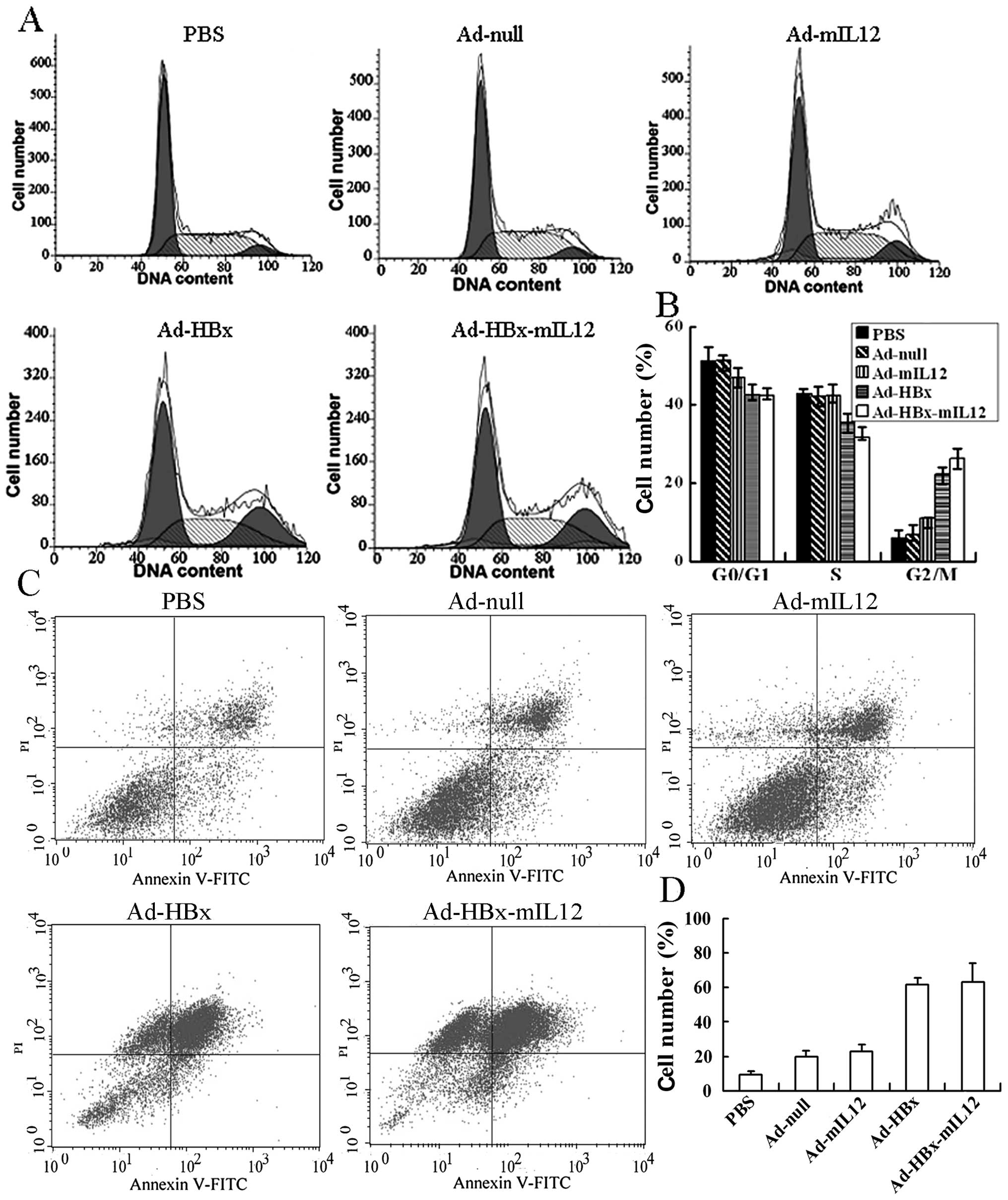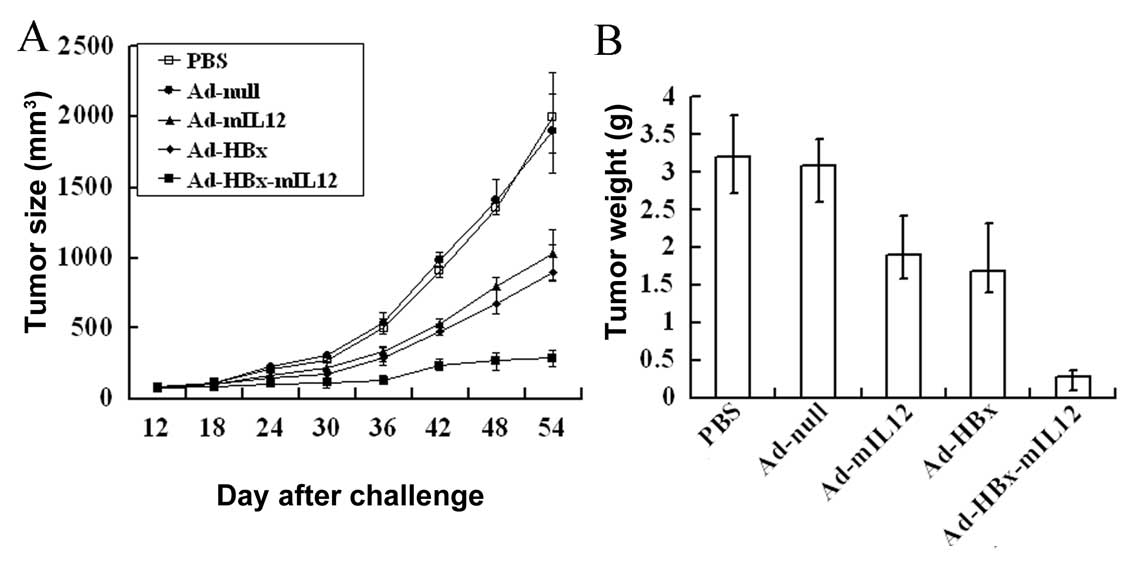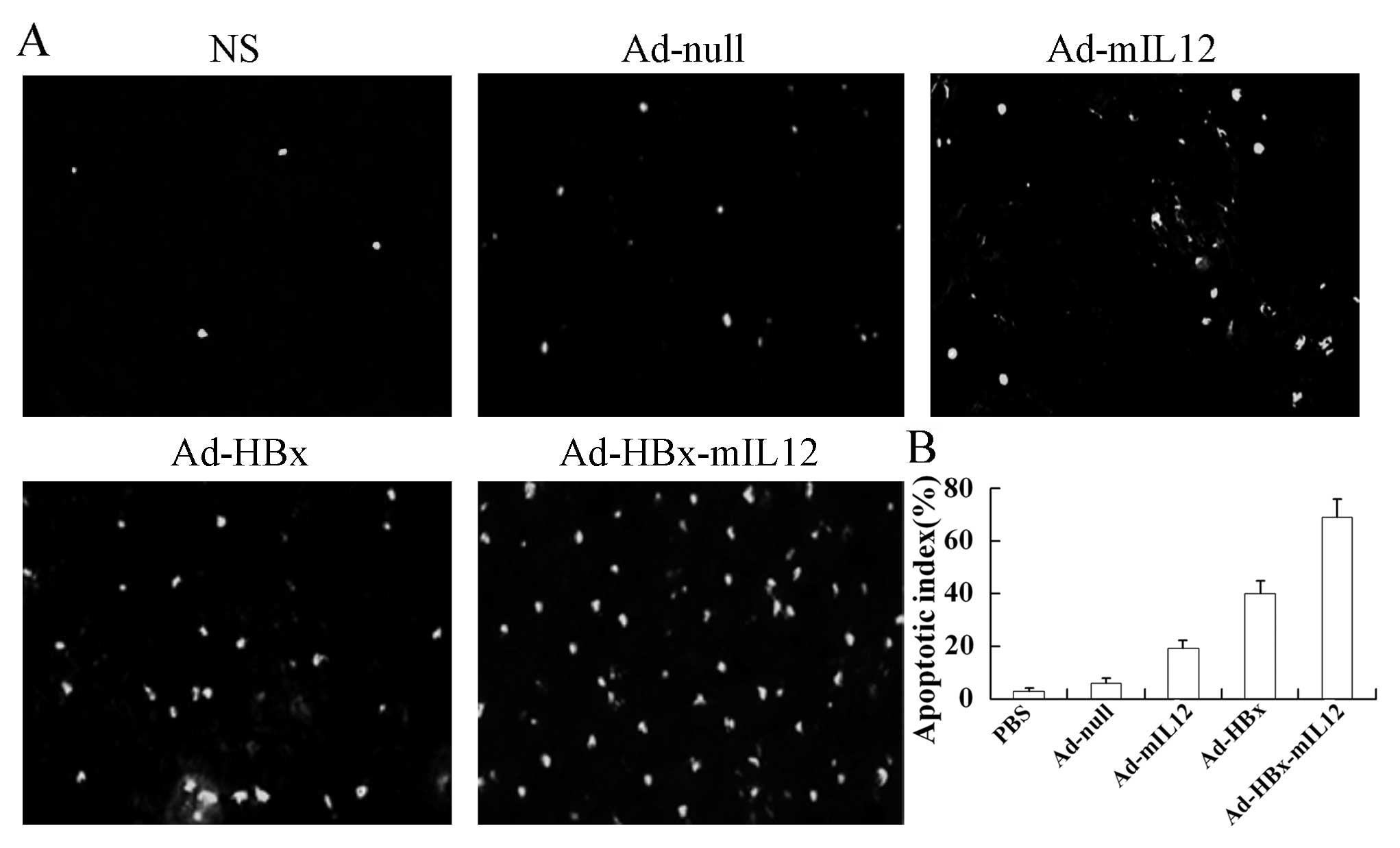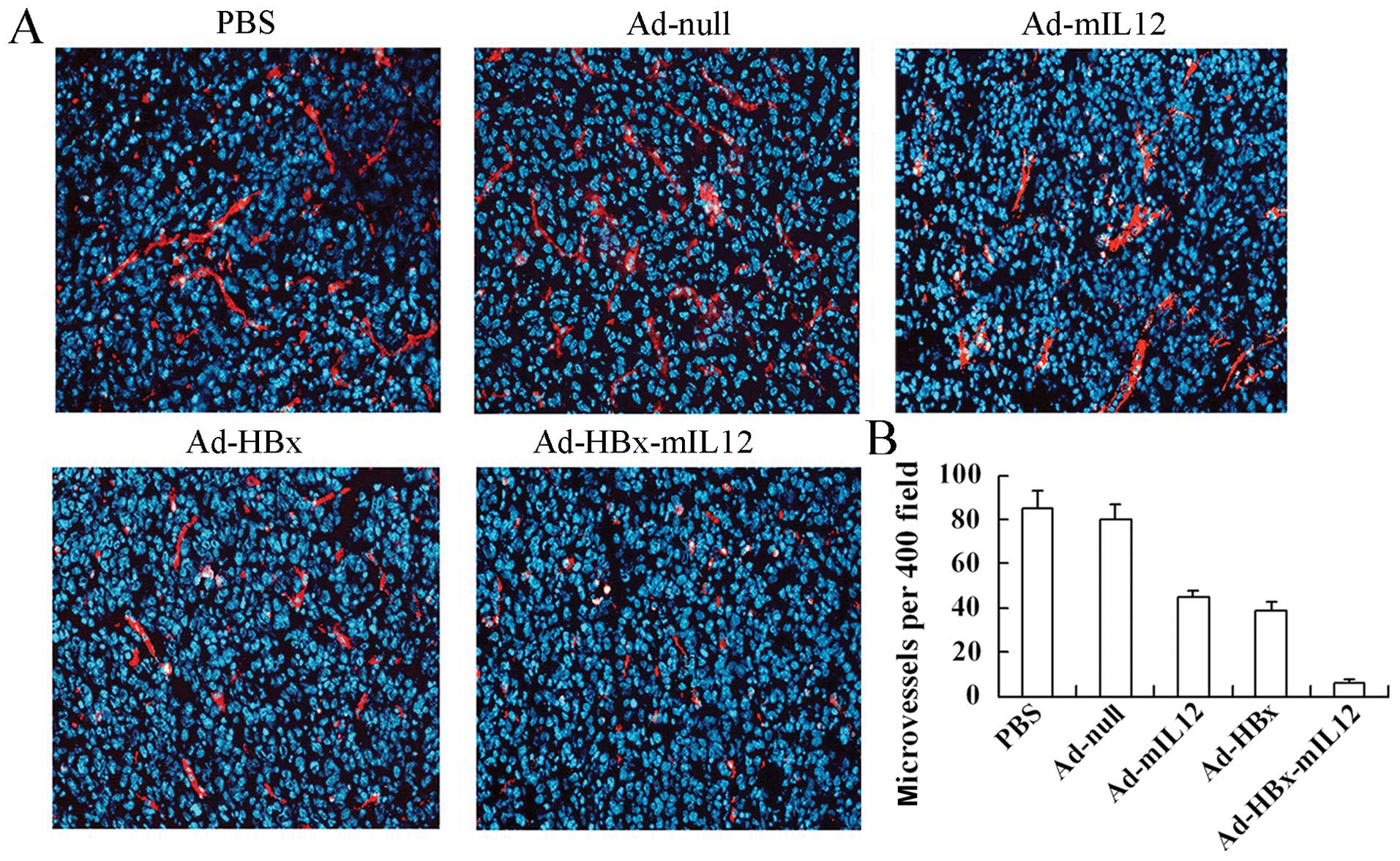Local delivery of recombinant adenovirus expressing hepatitis B virus X protein and interleukin-12 results in antitumor effects via inhibition of hepatoma cell growth and intervention of tumor microenvironment
- Authors:
- Published online on: June 12, 2012 https://doi.org/10.3892/ijmm.2012.1027
- Pages: 599-605
Abstract
Introduction
Hepatocellular carcinoma (HCC) is one of the most common and recurrent malignancies worldwide (1). Although the surgical techniques and various nonsurgical treatment modalities have improved, none of these therapies has significantly improved the extremely poor prognosis and the overall 5-year survival rate worldwide is only 2% (2). It is imperative that novel strategies against HCC are identified.
Hepatitis B virus X protein (HBx) is an HBV-encoded protein with multiple functions in transcription pathways, signal transduction, cell cycle progress and HBV replication (3). Studies have demonstrated that HBx could inhibit hepatocarcinoma cell growth via inducing apoptosis. In our previous studies, we showed that treatment with Ad-HBx intratumorally could not only induce apoptosis but also suppress angiogenesis (4).
HCC is a typical hypervascular tumor and tumor angiogenesis is required for both growth and metastasis of HCC (5,6). Most patients show disease recurrence that rapidly progresses to the advanced stages with vascular invasion and multiple intrahepatic metastases (7). Our laboratory demonstrated that implantation of mesenchymal stem cells (MSCs) that are genetically modified with adenovirus vector encoding interleukin-12 (IL-12) could significantly suppress HCC tumor growth in vivo via inhibiting tumor angiogenesis (8).
Not only neovascular endothelial cells that are critical components of the tumor microenvironment, but also the immunocytes in the tumor stroma can affect tumor prognosis through participating innate and adaptive immunity (9). Many studies showed that HBx could elicit cytotoxic T lymphocyte (CTL) antitumor immune responses. Vaccines based on HBx full-length sequence or specific epitopes could trigger significant immune reactions (10–13). Our previous studies showed that immunotherapy with Ad-HBx vaccine induced a massive accumulation of CD8+ T cells at the tumor site and accordingly elicit the host CTL response against HBV-associated HCC (11). Intratumoral injections with Ad-HBx induced not only apoptosis of HCC cells but also lymphocytes infiltration in the tumor stroma.
IL-12 as a heterodimeric cytokine, has potent anti-tumor activity and anti-metastatic effect. A large number of animal experiments demonstrated that IL-12 could inhibit tumor angiogenesis and participate in immunoregulation (14,15). IL-12 significantly promoted the NK cell and T cell proliferation, induced the production of IFN-γ and stimulated naive CD4+ T cells to differentiate toward the Th1 phenotype (16–18). Recently, combination IL-12 with other treatment options was proved to be a better anti-tumor effect with lower side-effect (19–21).
In this study, to further investigate the regulatory effect of IL-12 on HBx mediated intervention of hepatoma microenvironment especially on intervention of neovessels and immune microenvironment, we constructed the recombinant adenovirus carrying HBx and mIL-12 named Ad-HBx-mIL-12.
Materials and methods
Cell lines and adenovirus preparation
Hepa1-6 (mouse HCC) cell line, which was purchased from the American Type Culture Collection, was cultured in DMEM medium (Gibco-BRL) with 10% fetal bovine serum (FBS; Gibco-BRL) and 10 μg/ml gentamicin sulfate at 37°C in 5% CO2. Ad-HBx-mIL-12 is an E1, E3-deleted recombinant adenoviruse (rAd) expressing the HBx and murine IL-12. Ad-HBx, Ad-mIL-12 and Ad-null are E1, E3-deleted rAd expressing the HBx, murine IL-12 and no transgene, respectively. All recombinant adenoviruses were constructed and conserved by our laboratory.
Hepa1-6 cell cycle and apoptosis assay in vitro
Hepa1-6 cells were plated into 6-well plates at 5.0×105 cells/well, overnight. Then, cells were left untreated or infected with Ad-null, Ad-mIL-12, Ad-HBx and Ad-HBx-mIL-12. After 48 h, cell cycle profiles (MOI 10) and apoptosis (MOI 30) were analyzed by flow cytometer (Beckman Coulter) after propidium iodide (PI) staining or Annexin V-phycoerythrin/PI staining, respectively.
In vivo studies
Female syngeneic C57BL/6 mice, 6–8 weeks old, were obtained from Beijing Hua Fu Kang biological technology company and maintained in pathogen-free conditions. All procedures were reviewed and approved by the Institute Animal Care and Use Committee. Mice were challenged subcutaneously with 5×106 Hepa1-6 cells in the right flank. When tumors had reached the desired size (100 mm3), mice were grouped randomly (n=10) and treatment was initiated. Ad-null, Ad-HBx, Ad-mIL-12 and Ad-HBx-mIL-12, diluted in 100 μl sterile 1x PBS (Sigma-Aldrich), were administered 4 times, 5 days apart, intratumorally, at the dose of 108 plaque-forming units (pfu). Tumor dimensions were measured with calipers every 3 days and tumor volumes were calculated according to the formula: V = length × width2 × π/6.
Tumor microenvironment analysis
For FACS analysis, we prepared single-cell suspensions of tumors from untreated or treated mice. Briefly, tumors were minced using a sterile razor blade and digested with collagenase I. For extracellular staining of immune markers, 1×106 of freshly prepared cells were stained with different combinations of fluorochrome-coupled antibodies to CD4, CD8, CD11b, CD11c, F4/80 and Gr1 (BD Biosciences). Fluorescence data were collected on FACScalibur and analyzed using cell quest software (BD Biosciences).
Immunohistochemistry
Three days after the completion of treatment, the mice were sacrificed for histological analysis. The tissues were fixed in 4% paraformaldehyde. Primary tumors were embedded in paraffin and cut into 3–5 μm sections. The apoptotic cells within the tumor sections were evaluated by TUNEL staining, using DeadEnd™ Fluorometric TUNEL System (Promega). Apoptosis index was determined by counting the number of apoptotic cells and dividing by the total number of cells in the field (5 high power fields/slide). Frozen tumor tissues were stained for the quantification of microvessel density (MVD) using a monoclonal rabbit anti-mouse CD31-phcoerythrin conjugate (Santa Cruz Biotechnology, Inc.).
Toxicity evaluation
To investigate potential side effects or toxicity in the treated mice, they were observed continuously for relevant indexes such as weight loss, ruffled fur, diarrhea, anorexia, cachexia, skin ulceration or toxic deaths. After fixing in 4% neutral buffered formalin solution more than 24 h, the tissues of heart, liver, spleen, lung, kidney and brain were embedded in paraffin. Slices of 3–5 mm were stained with hematoxylin and eosin (H&E) and observed in double blinded manner.
Statistical analysis
SPSS 17.0 was used for statistical analysis. Data were expressed as the mean ± SE. The statistical analysis in all the experiments was performed using one-way analysis of variance (ANOVA) or unpaired Student’s t-test. P-values <0.05 were considered significant.
Results
HBx-mIL-12 induces HCC cells to cell cycle arrest and apoptosis in vitro
Hepa1-6 cells were left untreated or infected by Ad-null, Ad-mIL-12, Ad-HBx and Ad-HBx-mIL-12. After 48 h, cell cycle profiles (MOI 10) and apoptosis (MOI 30) were analyzed by flow cytometer. Results showed that Ad-HBx and Ad-HBx-mIL-12 induced a significant accumulation of cells in G2/M phase accompanied by a decrease in the percentage of cells in G0/G1 phase and S phase (Fig. 1A). The percentages of Ad-HBx and Ad-HBx-mIL-12 infected Hepa1-6 cells in G2/M phase were 22.25±1.8% and 26.15±2.1%, respectively, and higher than those of untreated, Ad-null and Ad-mIL-12 infected cells (P<0.01) (Fig. 1B). With increasing MOI, flow cytometric analysis revealed that Ad-HBx and Ad-HBx-mIL-12 infected cells underwent significant apoptosis (Fig. 1C). The percentages of apoptosis in Ad-HBx and Ad-HBx-mIL-12 infected groups were 63.17±5.2% and 61.68±3.1%, respectively, and higher than those of untreated, Ad-null and Ad-mIL-12 infected groups (P<0.01) (Fig. 1D). According to our flow cytometric analysis, the cell cycle arrest and apoptosis in Ad-HBx and Ad-HBx-mIL-12 infected groups have no significant deviation. These results indicate that HBx could induce HCC cells to G2/M arrest and apoptosis, whereas mIL-12 has no function in inducing cell cycle arrest and apoptosis of HCC cells in vitro.
HBx-mIL-12 inhibits the growth of HCC in vivo
A murine hepatic carcinoma model was established to investigate the anti-tumor effect of Ad-HBx-mIL-12 in vivo. When tumors had reached the desired size (100 mm3), Ad-null, Ad-HBx, Ad-mIL-12, Ad-HBx-mIL-12 or PBS was administered intratumorally. Alterations in tumor growth were monitored every 3 days (Fig. 2A). The Ad-HBx-mIL-12 group exhibited effective inhibition of tumor growth, compared to the other groups (P<0.01). On Day 54 after the Hepa1-6 cells were challenged, the mice were sacrificed and the tumor weights were measured (Fig. 2B). We observed that treatment with Ad-HBx-mIL-12 resulted in average tumor weight reductions of 85.6±4.9%, 85.1±2.8%, 75.8±6.1% and 72.8±5.6% compared to PBS, Ad-null, Ad-mIL-12 and Ad-HBx, respectively (P<0.01). These results indicate that Ad-HBx-mIL-12 can effectively suppress tumor growth.
HBx-mIL-12 induces apoptosis of HCC cells in vivo
In order to estimate the apoptosis in tumor tissues, TUNEL staining was applied to the tumor sections. We observed more apoptotic cells in the tumor sections of mice treated with Ad-HBx-mIL-12 than with PBS, Ad-null, Ad-mIL-12 and Ad-HBx (Fig. 3A). The apoptosis index also showed that the Ad-HBx-mIL-12 displayed the highest indices among all the groups (Fig. 3B).
HBx-mIL-12 inhibits vascular endothelial cell growth in vivo
We further investigated whether Ad-HBx-mIL-12 also had inhibitory effects on tumor-stromal cells besides HCC cells within treated tumor tissue. Angiogenic blood vessels within tumor tissue were detected by CD31 immunohistochemistry. The frozen sections were stained for angiogenic blood vessels using a monoclonal rabbit anti-mouse CD-31-phcoerythrin conjugate and counterstained with DAPI (Fig. 4A). Tumors of the control groups (including PBS, Ad-null, Ad-mIL-12 and Ad-HBx groups) showed larger microvessel count than those of Ad-HBx-mIL-12 group (Fig. 4B).
HBx-mIL-12 causes a significant increase in tumor-infiltrating CD8+ T-cell
To further assess the role of immune modulation in the observed antitumor effects mediated by Ad-HBx-mIL-12 treatment, we analyzed the modulation of tumor microenvironment. The ratio of T cells within the tumor microenvironment is considered indicative of the effect of adaptive immune responses on tumor progression and metastasis (19,20). We investigated the subsets of tumor-infiltrating T-cell populations by staining with anti-CD4-PE and CD8-fluorescein isothiocyanate. Although Ad-HBx-mIL-12 treatment did not induce significant change in the ratio of CD4+ T-cells, we observed an increase in the infiltration of total CD8+ T cells in the tumor stroma, as shown by flow cytometric analysis (Fig. 5A). These effects probably result from HBx and mIL-12 mediating host CTL response.
HBx-mIL-12 induces an increase in tumor-infiltrating DCs and macrophages
It has been documented that tumor-infiltrating dendritic cells (DC) and macrophages are potentially able to induce an antitumor innate and adaptive immune response (9). We therefore assessed DCs (CD11b+CD11c+) and tumor-infiltrating macrophage (F4/80+CD11b+) populations by flow cytometry, which showed an increase in DCs and macrophages in tumors after local treatment with Ad-HBx-mIL-12 and Ad-mIL-12 (Fig. 5B and C). However, the increased ratios of DCs and macrophages in Ad-mIL-12 and Ad-HBx-mIL-12 treated tumors have no significant deviation. The numbers of tumor-infiltrating DCs and macrophages in Ad-HBx and Ad-null treated tumors have no significant increase compared with that in PBS group. These results indicate that the increased ratios of tumor-infiltrating DCs and macrophages potentially result from IL-12 mediating the immune responses.
HBx-mIL-12 has no impact on the percentage of MDSCs in tumor microenvironment
Myeloid-derived suppressor cells (MDSCs) in the tumor microenvironment produce growth factors and angiogenic factors critical for tumor progression (20,21). Thus, a large number of MDSCs in tumor microenvironment have probably suppressive actions in the treatment of tumor. We therefore assessed MDSCs (Gr1+CD11b+) populations by flow cytometry, which showed the percentage of MDSCs in Ad-HBx-mIL-12 treated tumors did not have significant changes compared with control groups (including PBS, Ad-null, Ad-mIL-12 and Ad-HBx groups) (Fig. 5D). These result indicate that Ad-HBx-mIL-12 have no effect on decreasing the percentage of MDSCs in tumor microenvironment.
Discussion
In the present study, we demonstrated that HBx-mIL-12 has more anti-tumor effect when compared with HBx or IL-12, as shown in our previous studies (4). In vitro, we found that Hepa1-6 cells infected with Ad-HBx and Ad-HBx-mIL-12 underwent G2/M arrest and apoptosis. However IL-12 did not affect the function of HBx. In vivo, we established a mouse tumor model and performed intratumoral injection of Ad-HBx-mIL-12. We found that although IL-12 did not affect the function of HBx in vitro, combination of IL-12 with HBx induced higher apoptotic effect than HBx or IL-12 in vivo. Combination of IL-12 with HBx led to an almost complete eradication of HCC. The anti-tumor mechanisms of HBx-mIL-12 are due not only to induction of cell cycle arrest and apoptosis in HCC cells, but also effectively shift the tumor microenvironment from pro-oncogenic to anti-tumor.
Although tumors are capable of autonomous growth, their progression is highly influenced by their stromal component (22). T cells, tumor-infiltrating DC, tumor-associated macrophages and myeloid cells are critical components of the tumor microenvironment and the cells may exert either inhibiting or promoting effects on tumor growth (23) through participating innate and adaptive immunity (21,24,25). The ratio of T cells within the tumor microenvironment is considered indicative of the effect of adaptive immune responses on tumor progression and metastasis (19). Abundant CD8+ T-cell infiltration in the tumor stroma is associated with a favorable course of malignancy in cancer (26–29). Previous studies have demonstrated that HBx could induce infiltration of CD8+ T lymphocytes in HBx-positive tumors (11). In addition, IL-12 can induce an efficient antitumor CD8+ CTL response which is regarded as the major mediators of the natural host response against developing tumors (30,31). Thus, there is a hypothesis that IL-12 can enhance CD8+ CTL response elicited by HBx. In our study, increased T cell infiltration, especially CD8+ cells, can be detected in tumor tissue of mice treated with Ad-HBx-mIL-12 compared to control groups. This observation is consistent with other studies, indicating that a higher infiltration CD8+ ratio within the tumor microenvironment has been correlated with a favorable response to the treatment, as compared with unchanged ratios in non-responders.
Many studies have definitively shown that recruitment of various antigen-presenting cells, such as dendritic cells (DCs) and macrophages, within tumors can initiate a cascade of innate, adaptive or humoral immune responses against growing tumors (20,32,33). Our study showed an increase in the infiltration of DCs and macrophages in the tumor stroma, after local treatment with Ad-HBx-mIL-12 and Ad-mIL-12. However, the increased ratios of DCs and macrophages in Ad-mIL-12 and Ad-HBx-mIL-12 treated tumors have no significant deviation. These results indicate that the increased ratios of tumor-infiltrating DCs and macrophages potentially result from IL-12 mediating the immunological reaction. Indeed, our findings support the view that IL-12, a key cytokine in cancer immunoprevention, seems to induce infiltration of activated DCs and macrophages to tumor and different organs (34,35).
In our study, treatment with Ad-HBx-mIL-12 reduced the number of angiogenic blood vessels within tumor tissues compared with control group. Studies have shown that MDSCs in the tumor microenvironment produce growth factors and angiogenic factors critical for tumor progression (21). However, the percentage of MDSCs in treated tumors did not decrease compared with control groups. The anti-angiogenic property of IL-12 was well documented in different in vitro and in vivo studies (36,37). In our previous study, treatment with Ad-HBx apparently reduced the number of angiogenic blood vessels within HCC tumor tissue (4). Thus, the mechanism of the anti-angiogenic effect of Ad-HBx-mIL-12 in the present study may result from IL-12 and HBx mediated the anti-angiogenic effects.
In our study, treatment with Ad-HBx-mIL-12 not only induced cell cycle arrest and apoptosis in HCC cells, also induced a massive accumulation of immune cells (CD8+ T leukocytes, macrophages and DC) and significant reduction of vascular endothelial cell growth tumors in situ. HBx-mIL-12 could shift the tumor microenvironment from pro-oncogenic to antitumor not only through recruitment immune cells but also inhibiting stromal cell growth. Collectively, our data in the present study suggest that local delivery of Ad-HBx-mIL-12 could result in antitumor effects via inhibition of hepatoma cell growth and intervention of tumor microenvironment.
Acknowledgements
This study is supported by the National Natural Science Foundation of China (Grant no. 81101728), the National Science and Technology Major Projects of New Drugs (Grant no. 2012ZX09103301-036), the National Science and Technology Major Project for Infectious Diseases Control (Grant no. 2012ZX10002014-004) and the Research Fund for the Doctoral Program of Higher Education of China (Grant no. 20110181120086).














